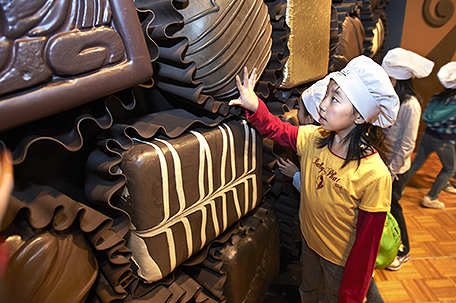
ABOVE PHOTO: Chocolate: The Exhibition, on view Oct. 11-Jan. 24, 2015, explores the natural and cultural history of the world’s favorite treat. (Credit: ©The Field Museum, John Weinstein)
A unique tropical tree. A seed so precious it was used as money. A spicy drink and a sweet snack. A multi-billion-dollar worldwide business. Chocolate is all this and much more. Indulge in the sumptuous world of chocolate starting Saturday, Oct. 11, when “Chocolate: The Exhibition”, opens at the Academy of Natural Sciences of Drexel University.
“Chocolate” traces the intriguing story of this “food of the gods” from its origin as a unique tropical rain forest plant, to the Aztecs who used cacao seeds as currency, to the Spanish who added sugar and transformed the bitter drink of kings, to the sensuous sweet millions of people crave today. Chocolate brings to life the rich history and wide impact the treat has had across the globe. It’s a sweet experience that engages all the senses and reveals facets of chocolate most people have never thought about before.
On view from Oct. 11 through Jan. 24, 2015, “Chocolate” is presented in both Spanish and English. There is a $5 fee to enter the exhibit in addition to regular museum admission. Visit the Academy’s website, ansp.org, for details about opening weekend festivities including chocolate foods and crafts presented with the Mexican Cultural Center to celebrate Hispanic Cultural Weekend.
Visitors to Chocolate: The Exhibition will explore the plant, the products, the history, and the culture of chocolate through the lenses of botany and ecology, anthropology and economics, conservation and popular culture. Visitors can:
• Stand beneath a cacao tree in a lush rain forest replica and examine cacao seed pods up close.
• Engage with animated modern-day machinery that turns cacao from seed to sweet, solid bar.
• Follow a cacao harvest on a Mexican plantation and cacao’s preparation for market.
• Barter cacao seeds for goods in an Aztec market and learn about Quetzalcoatl, the god who brought the sacred source of chocolate to the Aztec.
• Interpret glyphs on a royal Maya pot and see archaeological vessels that once held the drink of kings.
• Admire beautiful porcelain and silver chocolate services from Europe.
“Chocolate: The Exhibition will change the way you enjoy chocolate,” said Director of Exhibits Jennifer Sontchi. “The fun of the exhibit is that afterwards, every bite of chocolate you taste is richer for what you learned about it here.”
The plant and the midge
Philadelphia has played a key role in the chocolate industry for more than 200 years and remains an important port for shipments of cacao and other ingredients used to make chocolate products. “The cuisine culture of Philly is one of the things that sets it apart, and numerous major chocolate companies are based in this region,” said Mary Bailey, special exhibits educator.
Bailey and her team will augment the exhibit with mobile “touch carts” bearing teaching treasures including a real cacao pod, monkey fur, puff balls, chocolate midges, snake skin, an okapi skull, and easy-to-digest information about the rainforests where cacao plants grow. Fall marks the debut of a new type of educational cart for engaging visitors, one that Bailey calls the tech cart.
“It has a digital screen where we can show magnified images, so groups of people can see dissections of flowers, fruits and pods and even look at the cells of an onion skin,” Bailey said.
Visitors also will see up close a very tiny insect, a midge, on which the $50 billion-a-year chocolate industry depends. It’s a fly that closely resembles a mosquito, and many scientists believe it is the only creature that pollinates the cacao tree, Theobroma cacao. Without the midge, there would be no cacao plant.
“Theobroma cacao has been the basis of a globalized industry for almost 500 years, yet we still know remarkably little about its pollination,” said Academy Curator of Botany Tatyana Livshultz, who studies pollination. “The first pollination study on wild plants was published only last year. Under cultivation, fruit set in T. cacao is pollination limited, so optimizing pollination can have a major impact on the global supply of cacao.”
Another interesting aspect is that cacao is different from many other trees. It grows in the shade of larger trees in tropical regions of Central America, South America, Africa and Asia. It is relatively short—30 to 40 feet tall—and has lovely, delicate flowers that grow directly on the trunk and lower branches, where the low-flying midges can reach them.















Leave a Comment